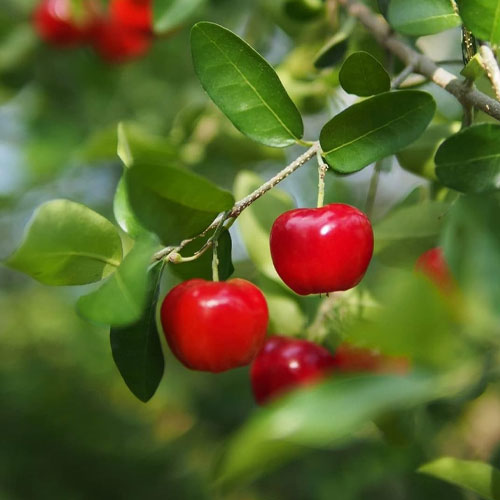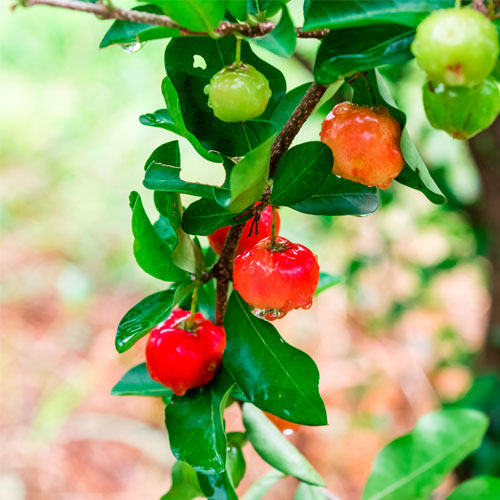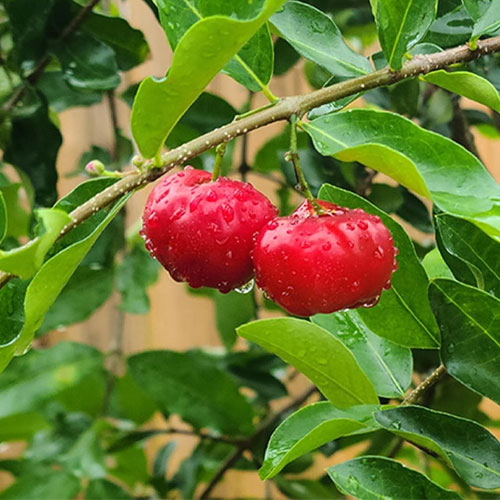The West Indian Cherry Layered Live Plant, also known as Acerola or Barbados Cherry, is a tropical evergreen fruit tree prized for its bright-red berries rich in Vitamin C. Each cherry is sweet-tart, juicy, and perfect for fresh eating or making juices, jams, and desserts. Grown and layered by Golden Hills Farm, this plant establishes quickly, fruits early, and thrives beautifully in India’s warm climate. Apart from its nutrition, the tree itself is compact, glossy-leaved, and ornamental, making it a great choice for terrace gardens and home orchards.
Type of Plant: Layered Fruit Plant – West Indian Cherry (Acerola / Barbados Cherry)
Scientific Name: Malpighia emarginata
Germination Time: 10 – 15 days (for new shoots after planting)
Sunlight Requirements: 6 – 8 hours of direct sunlight daily
Where to Grow: Terrace gardens, balconies, backyards, or open fields
Growing Season: Best planted June – September or February – April
Soil Requirements: Well-drained loamy soil mixed with organic compost
Plant Height: 1.5 – 2 feet (at dispatch)
Fertilizer Needs: Organic compost or cow dung once every 30–40 days
Life Span: Long-lived perennial tree (20 + years of fruiting)
Ideal Growing Temperature: 22 °C – 34 °C
Blooming / Harvesting Time: Flowers in spring; fruits twice a year
Maintenance Required: Low; light pruning after fruiting
Watering Frequency: 2–3 times a week during summer
Ideal Grow Bag Size: 18 × 18 inches or larger



The West Indian Cherry Plant flourishes across India’s tropical and coastal zones. It can be planted year-round where winters are mild, but the best time is monsoon (June–September) or spring (February–April). Once established, it produces two heavy crops annually – in spring and again in autumn – delivering clusters of nutrient-packed red cherries.
Use a large 18×18 inch pot or grow bag with drainage holes. Fill it with a mix of garden soil, compost, and sand. Place the plant upright, cover roots, and water well. Keep the pot in a sunny spot (6–8 hours daily). Feed organic fertilizer once a month and keep soil moist but not soggy.
Preparation: Mix loamy soil with compost and sand for aeration.
Planting: Dig a 1×1×1 ft pit, place the layered plant upright, and refill with soil.
Watering: Water deeply after planting and every 2–3 days for two weeks.
Germination: Layered plants establish quickly and fruit in 1–2 years.
Transplanting: Shift to open ground or larger pots as it matures.
Sunlight: Needs full sunlight for best flowering and fruiting.
Soil: Keep well-drained and nutrient-rich.
Fertilization: Add cow dung, neem cake, or organic compost monthly.
Pruning: Trim after harvest to encourage new shoots.
Support & Spacing: Keep 4–5 ft spacing for open planting.
Pest Control: Use neem oil spray to deter aphids and ants.
Disease Prevention: Avoid overwatering; ensure air circulation.
Mulching: Add dry leaves or coconut husk around the base.
Harvesting: Fruits ripen when bright red and glossy.
1. Apply Nutrient-Rich Fertilizers
When your plants begin flowering, use nutrient-rich fertilizers like Organic Bone Meal Powder or Vermicompost. This helps in boosting the bloom and enhances overall yield.
2. Use Organic Fertilizers
Feed your plants with organic fertilizers such as Cow Dung Manure or Neem Cake. Organic options promote healthy soil life.
3. Regular Feeding
Apply fertilizers every 20-25 days to ensure plants receive a steady supply of nutrients. Choose from various options like Cocopeat Compost for moisture retention.
The West Indian Cherry Plant is renowned for its extremely high Vitamin C content – up to 30 times more than oranges. It is compact, fast-growing, and produces beautiful pink flowers followed by clusters of scarlet cherries. Its layered propagation ensures early fruiting and true-to-type yield. This tree adds both beauty and nutrition to your garden with minimal maintenance.
Richest natural source of Vitamin C.
Perfect for fresh eating, juices, jams, and desserts.
Compact tree ideal for pots and terraces.
Flowers beautifully twice a year.
Strengthens immunity and improves overall health.
Protect young plants from frost or extreme cold.
Avoid overwatering to prevent root rot.
Provide full sunlight for sweet fruits.
Use only organic fertilizers for best flavor.
Prune lightly after harvest to encourage new growth.
Problem: Leaf curl or yellowing.
Solution: Improve drainage and spray neem oil.
Problem: Flower drop before fruiting.
Solution: Water consistently and apply organic fertilizer.
Problem: Slow growth in shade.
Solution: Relocate to a brighter location with 6–8 hours of light.
Acerola Cherry, Barbados Cherry, Malpighia, Jamaica Cherry, Pond Cherry, Nelli Cherry, Karonda Chetty Mavu, Surinam Cherry Fruit, Vitamin C Fruit Tree.
Q1: When does the West Indian Cherry start fruiting?
👉 Usually within 1–2 years after planting (layered variety).
Q2: Can it grow in pots?
👉 Yes, it grows beautifully in large pots with full sunlight.
Q3: How often does it fruit in a year?
👉 Typically two harvests – spring and autumn.
Q4: Is the fruit sweet or sour?
👉 It has a pleasant sweet-tart flavor with juicy pulp.
Sign in now to receive a 5% instant discount on your first order when using code WELCOME. Begin your organic journey today!
By logging in, you're agreeing to our Terms of Service and Privacy Policy.
Anjali George
Healthy aur rare variety. Terrace garden ke liye perfect hai. Delivery fast thi. 👍
Suresh Bhat
Plant well-rooted tha aur soil moist thi. Early fruiting variety ke liye best buy. 🌿
Kavya Reddy
Plant ka health perfect tha. Fruits ka wait hai ab. Compact aur easy to maintain plant. 🍒
Rajesh Verma
Beautiful small leaves aur glossy finish. Packaging neat thi aur delivery time par. 👍
Pooja Desai
Layered plant strong aur stable tha. Pot me shift karne ke baad growth fast hai. 🌿
Nikhil George
Plant healthy tha par thoda dry lag raha tha. Ab paani dene ke baad revive ho gaya. 🌱
Meera Pillai
Compact aur lush green plant. Fruits dekhne ka wait nahi ho raha. Golden Hills Farm best hai. 🍒
Harish Rao
Healthy aur strong plant. Roots visible aur packaging bilkul safe thi. Highly satisfied. 🌿
Divya Nair
Plant thoda chhota tha but leaves healthy aur pest free thi. Daily sunlight me rakha hai. 👍
Rohit Menon
Fast delivery aur moist soil. Plant compact aur green tha. Layered plant ke liye worth buying. 🌱